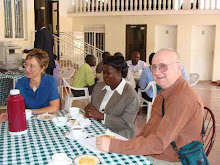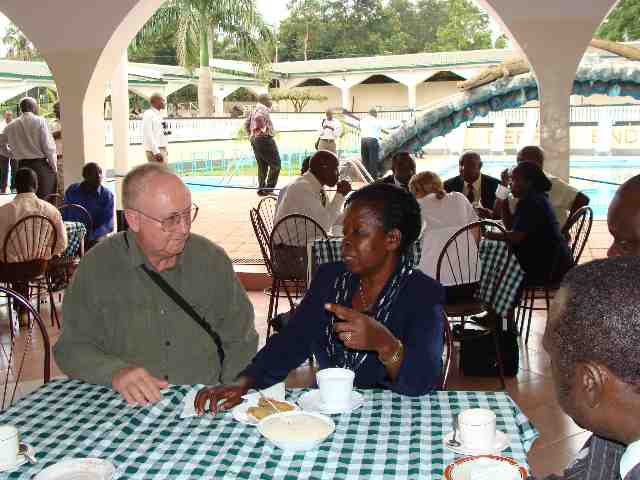3 Feb through 6 Feb 2008
Janet has asked how the food is. In some ways it’s got to be better. The roadside shops have every conceivable tropical fruit available. In St Peter’s House (my former dinning room) there was a good supply of pineapple (at least as good as Hawaii), po po (papaya) and bananas. The archbishop’s table always has bananas. The greens are called kelp, but don’t come from the sea, and are a bit like spinach. Some of the bread would make Montana Mills proud. Much of the diet is cooked into a paste like substance that would remind us of rising bread dough. That includes millet, bananas and a few things I’ve forgotten. The meats and fishes are prepared by boiling. It kills the germs, but the result is a bit like rubber. Everyone here uses recycled wine bottles, which contains their chilled water (after boiling). I’m still using factory sealed bottled water. The other water should be pure, but the handling of the bottles could contaminate the otherwise pure water. It would be an ironic way to get sick since I’m hoping to stimulate improvements in pure water availability. Oh, the local beers are really top shelf, Bell, Nile and Pilsner. The taste is delicious after a day in the tropical heat. The Bell would go head to head in a German beer taste test any day. Don’t get the wrong idea – it’s tasty in moderation. I wouldn’t want to scandalize the archbishop.
Gertrude, the cook, prepares our meals. Sr. Saloma directs her to be sure I’m eating the right sorts of healthy foods. Susan is a young widow with 3 children who works part time. She takes my laundry, scrubs it in a washtub, dries it and irons every piece. I’m grateful for her help and it gives her employment. It would take every bit of free time for me to keep up with just that task.
The water pressure was down to a tiny trickle this last week, so Patrick the plumber is working on the shower. He believed it to be an air lock in the line and has increased the flow somewhat. It will be a nice improvement if he’s successful, but this skeptic thinks it’s something more basic and external to this apartment’s plumbing. At least I can wash in a sink with warm water.
The blinking florescent tube above me is almost becoming invisible. I went to change it, but was unable to drop the troffer (reflective grid that covers the florescent tubes). Fr. Chris will task an electrician to fix it.
The only cultivation I’ve seen to-date has been hand digging. However, as I write this in my room, there is the distinctive sound of a tractor at work just outside the archbishop’s compound
Now for some actual progress. Leo Owora, the District Water Officer for Tororo and 17 sub counties, got word from the Minister of Water for Uganda that I was here. He got in touch with Fr. Andrew Obel and we met on 4 February in the diocesan offices. The meeting was genuinely informative. He provided a tabulation of bore holes (generally drilled deep wells), shallow wells and protected springs broken down by sub county and population served. The short story is that the majority of people are served by deep wells that have been tested as safe drinking water. But contamination becomes a problem because of the water handling methods between the hand pumps and the end user. Jerry jugs are used primarily by women and children to carry water considerable distances. Bicycles sometimes truck several of these 3 gallon jugs that once contained cooking oil. One local goal is to make bore hole available within 1.5 km for 50% of the people.
Mr. Owora is currently in the process of bidding a six-month contract for water testing services for some 500 water sources in the district. Testing will be performed for ecoli, cholera, turbidity, electrical conductivity and heavy metals. The heavy metals testing will be done in Kampala, several hours distant. The National Water & Sewerage Corporation will perform the lab analysis in its Tororo facility. New bore holes are routinely tested when put into service.
It turns out that the Tororo Water District includes two modern water treatment plants. We arranged to visit the Malaba Water Works which services 4000 customers in Tororo from about 6 km east of the Tororo Rock. The other plant is in Nagongera. There is also a spring fed gravity main that comes from the mountains east of Mbale to the Tororo railyard. It is currently defunct, but is being considered for restoration.
Mr Owora points out that the recommendation is to boil all water throughout the district (standard practice throughout the region). Some of the sources produce pure water, but contamination makes boiling necessary.
An engineer named Edmund of the National Water and Sewerage Corporation took us on the visitation of the Malaba Water Works. We stood on the intake structure and were within 20 meters of Kenya, a mere stone’s throw to the opposite bank. I’d love to visit, but with their current unrest I don’t want to be the cause of an international incident (much less loosing my head). Maybe later if things cool down. Fr. Tom has offered to take me, but we’ll keep that on the back burner just now. Besides, the US Embassy has some stern warnings about US citizens traveling there just now.
The Malaba River is narrow, but apparently deep. The plant is of modern German design and has two identical process paths, one built circa 1953 and the other in 1987. There are two intake structures, a sump for the lift pumps, clarifiers, sand filters, a backwash systems, chlorinators, clear wells and clear water pumps. The grounds are fenced and guarded by armed security personnel. The lawn is neatly mowed and you could imagine yourself to be in most any western town, except for the surrounding countryside, the cotton and tropical fruit. The discharge is piped some 5 kilometers up a rise of 230 meters to a concrete storage reservoir on Tororo Rock. Tororo Rock is one of those gigantic rock monoliths that you sometimes see in Colorado that rise hundreds or thousands of feet above the surrounding plane. 4000 customers are served by the network of piping in Tororo. Unfortunately the network is old cast iron and is prone to frequent ruptures and continuous leaks.
Mr. Owora told us about a national meeting of district water officers in Jinja, about an hour or hour and a half away, in Uganda’s second largest city. He agreed to check about possible attendance with the regional water officer, who could then check with the Minister of Water. We’ll soon know the result. In the meanwhile, a letter of introduction has been prepared for me to meet the Minister of Water, who seems to have already opened the doors of information for me.
I’ve taken lots of pictures and video, and am trying to keep them somewhat organized. Doing minimal editing of the video (clipping out some extraneous footage). Christopher, I should have brought you along as a videographer to keep my hands free. The real value in the video, besides showing folks the country and culture, will be to capture first-hand comments with officials and leaders in an interview setting. I’ll be able to report their statements without filtering their words.
Things sometimes happen quickly. It’s now 6 Feb (Ash Wednesday) and I’ll be going to Mbale to the regional water office with Leo Owora to meet the regional director. It would be hard to beat this level of cooperation from the Ugandan Water Ministry.
Well, it’s time to pack up and head for Mbale. If we return in time, there is a Rotary – Tororo meeting at 6 PM. I’m planning to present a banner from the Endwell Rotary.
Please be well and keep the home fires burning. By the way, is it cold in Endicott? Until the next update…..
skip to main |
skip to sidebar


Tea time with Minister of Water & Environment

Blog Archive
Cabinet Minister Maria Mutagamba
Tea time with Minister of Water & Environment